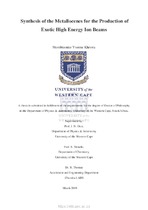| dc.contributor.advisor | Orce, Nico | |
| dc.contributor.author | Kheswa, Ntombizonke Yvonne | |
| dc.date.accessioned | 2019-04-12T13:07:47Z | |
| dc.date.available | 2019-04-12T13:07:47Z | |
| dc.date.issued | 2019 | |
| dc.identifier.uri | http://hdl.handle.net/11394/6664 | |
| dc.description | Philosophiae Doctor - PhD | en_US |
| dc.description.abstract | The Subatomic Physics Department of iThemba Laboratory for Accelerated Based Sciences (iThemba LABS) conducts experiments that require a variety of particle beams in order to study nuclear properties (reaction, structure, etc.) of various nuclides. These particle beams are accelerated using the K-200 Separated Sector Cyclotron (SSC) and delivered to different physics experimental vaults. Prior to acceleration, the particle beam is first ionised using an Electron Resonance Ion Source (ECRIS). The main goal of this study is the production of exotic metallic beams of 60Ni8+ and 62Ni8+ using ECRIS4, which are required for the Coulomb excitation experiments approved by the Programme Advisory Committee (PAC) at iThemba LABS.
In order to provide the metallic beams of nickel, a development study of organometallic materials containing 60Ni and 62Ni isotopes in a form of metallocene complexes was undertaken. The nickelocene (NiCp2) complex, a member of the organometallic family, was synthesised at the Physics Target Laboratory of iThemba LABS for the first time. Method development involved the use of natural nickel during the multi-step synthesis before the use of enriched nickel-60 (60Ni) and nickel-62 (62Ni).
Nine samples of NiCp2 were synthesised; two were isotopically enriched nickelocene (60NiCp2 and 62NiCp2). The percentage yields of the synthesised nickelocene samples ranged between 16 to 50 %, and samples were characterised by investigating their crystal structure and bonding arrangements in the complexes by X-ray diffraction (XRD) , Fourier Transform Infrared (FT-IR) spectroscopy, and Proton Nuclear Magnetic Resonance (1H NMR).
The synthesised nickelocene were further used with ECRIS4 for the production of Ni beams on the Q-line of the cyclotron. The Metal Ions from Volatile Compounds (MIVOC) technique was used for the conversion of 60Ni and 62Ni to ion species. The method used the organometallic compounds which are volatile at specific pressures at ambient temperatures.
Metallic ion beams of nickel were successfully produced after a carefully pre-sample conditioning in the MIVOC container before connecting the MIVOC set-up to the new injection system of the ECRIS4. Measured beam intensities during the experiment for both 60Ni+ and 62Ni+ were approximately 30 μA, optimum for physics measurements.
The development of the MIVOC technique opens up new beam-target combinations with the use of new exotic stable beams for new science cases at iThemba LABS. Reactions in inverse kinematics, multi-step Coulomb-excitation and other types of reactions will immensely benefit from these developments. | en_US |
| dc.language.iso | en | en_US |
| dc.publisher | University of the Western Cape | en_US |
| dc.subject | Organometallic compounds | en_US |
| dc.subject | Proton Nuclear Magnetic Resonance | en_US |
| dc.subject | Nickelocene complexesnds | en_US |
| dc.subject | Fourier transform Infrared | en_US |
| dc.subject | Metal Ions from volatile compounds | en_US |
| dc.subject | Metallic ion beams | en_US |
| dc.subject | Proton nuclear magnetic resonance | en_US |
| dc.title | Synthesis of the metallocenes for the production of exotic high energy ion beams | en_US |
| dc.rights.holder | University of the Western Cape | en_US |

